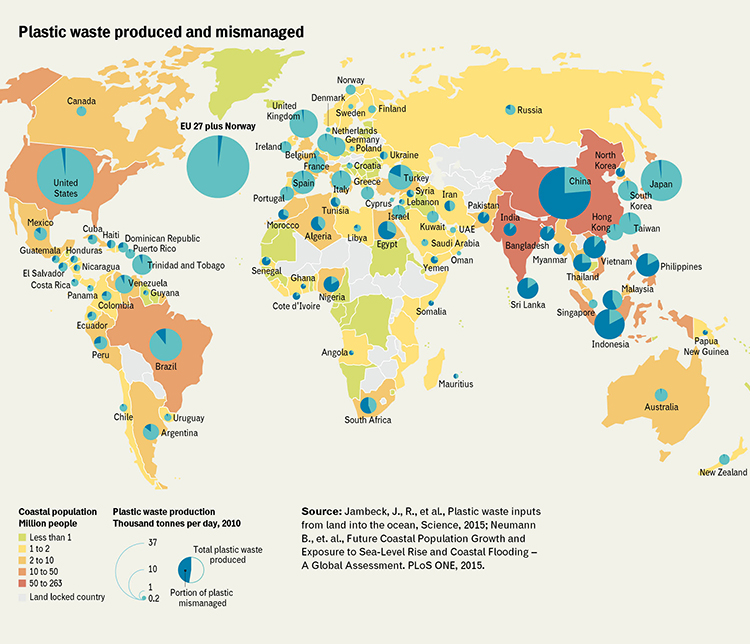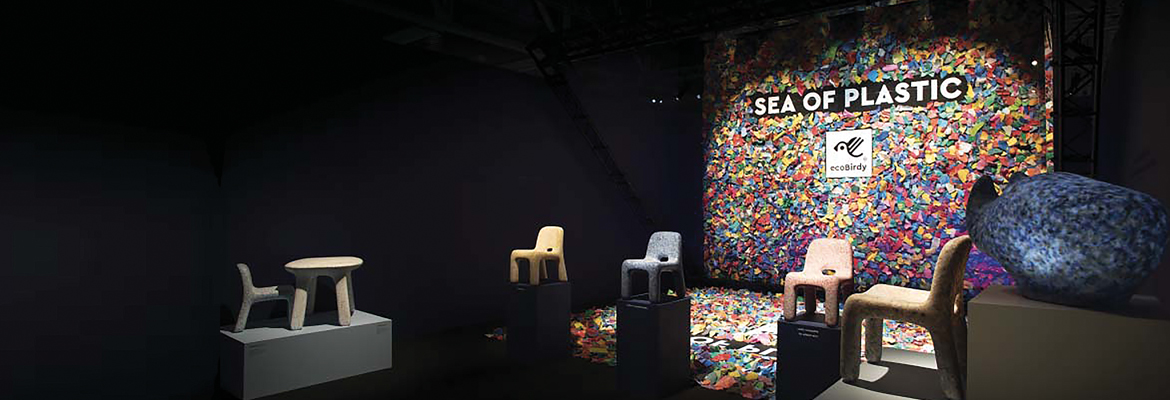When Daniel Webb opened his storage room, where for a whole year he had collected his plastic waste, a mountain of 4.490 bags, packaging, wrappings, containers, bottles, cups, cutlery, toothbrushes and other objects came pouring onto him. From then on, at the beginning of 2018, he started classifying all his waste, and discovered that 93% of it consisted of disposable containers, of which 63% was food packaging. Only 8 pieces in his collection were made of recycled plastic. He sorted and took pictures of this mountain of waste. The picture was then displayed as a mural where it remained as a warning against the decline of civilisation until May 21st in Margate, a lovely sea side resort in Kent. In the meantime, the British supermarket chain Sainsbury’s has decided to deal with a “worrying” trend, whereby Millennials eat ever less meat because they don’t like touching it. They therefore invented a special type of plastic packaging, that allows consumers to cook the meat by sliding it directly onto a pan without having to touch it. The next step will be a skinless banana wrapped in transparent film, to avoid having to peal it.

Daniel’s project, called Everyday Plastic, further confirms that we live in the age of plastic. If plastic has certainly improved our daily life in all kinds of ways, at the same time it has imprisoned us in a sea of waste and micro-pollution. According to a recent study by the American universities of California and Georgia, 8.3 billion tonnes of plastic have been produced since the 50s, when plastic became a mass-product. Researchers estimate that this mountain will grow to 34 billion tonnes by 2050. In the last five years the main petrochemical corporations have invested 159 billion euros in 318 new facilities that will lead to a 40% increase in the production of plastic from fossil fuels within the next decade. Of this enormous amount of plastic only 9% has been recycled so far, and 12% has been burnt in waste-to-energy plants, whereas 97% contributed to polluting the environment through dumping in landfills or in the sea.
This study – without a doubt one of the most complete in the history of the material – estimates that half of these 340 million tonnes of plastic produced every year, turn into waste after less than 4 years of use, whilst plastic bags are used on average for only 20 minutes. Furthermore, this will continue to be the status quo, considering that growth in production is spearheaded by disposable containers and bottles. Comparing this data to those on other ubiquitous materials like steel or concrete is depressing: “More than half of all the steel that is produced is employed in construction, and is therefore used for decades. With plastic it’s the other way around,” states the author of this study, Roland Geyer from the University of California in Santa Barbara, “More than half of all plastic materials become waste after a very short time, from 2 days to 4 years.” The marine ecosystem is the most badly affected. In a previous study the same team calculated that 8 million tonnes of plastic end up in the sea each year. According to the Ellen MacArthur Foundation, by 2050 seas will contain more plastic than fish. And experts are warning that plastic is already making its way through the human food chain, starting with tap water.
The highest contamination rate for water (94%) has been found in the United States, according to a study by Sherri Mason, a microplastics expert from the State University of New York in Fredonia. Basically all the water that comes out of American taps is polluted with plastic fibres. India is next in line. In Europe the situation is slightly better, but the percentage of polluted water is still as high as 72%. It’s not clear how all this plastic ends up in drinking water. However, according to researchers the most likely explanation is that microplatics are suspended in the atmosphere due to the daily wear and tear of synthetic materials, and are then carried by rain water where they end up in lakes and rivers.
Another 2016 study, performed by the University of Paris-Est in Créteil, discovered that 3 to 10 tonnes of microplastic fall over Paris every year, polluting the city’s air and water. “We believe that lakes and rivers have been contaminated by weather inputs” says Johnny Gasperi who conducted the study, “What we have observed in Paris demonstrates that a huge amount of fibres are present in the atmosphere.” Furthermore, research by the University of Plymouth has shown that almost a third of fish caught in the United Kingdom are contaminated with microplastic. Those who eat fish regularly ingest up to 11.000 plastic fragments a year, according to the conclusions of a study by the University of Grand. The European Authority for Food Safety has drawn attention to the need for a study on the effects of microplastics on the human organism (which remain highly speculative), especially when “considering the potential of pollution due to microplastic in commercial fish.”
What are the alternatives? On the one hand, increasing the recycling of existing non-biodegradable plastic as much as possible, in order to get rid of the need to produce more of it. On the other hand, substituting traditional plastic derived from petrol with bioplastic derived from renewable raw materials, that today represents only 1% of the annual world production of plastic: only 4 million tonnes of the 340 million tonnes of plastic produced.
In Europe, the strategy adopted by the EU Commission at the beginning of this year aims at recycling all plastic packaging by 2030: an ambitious goal if we consider that of the 26 million tonnes of plastic waste produced annually in the EU, only 30% is now recycled. Moreover, a significant part of this percentage is exported to external markets like China (that has recently announced a crackdown on the import of plastic waste), and only 6% is used in the production of new plastic in Europe. This value loss represents a cost for the European Union Economy amounting to 100 billion euros. The urgency to create a market for reclaimed material is therefore apparent. Nowadays, the market is highly constrained by a series of limitations that the new EU directives are trying to overcome.
At the end of March, the European Parliament Committee on the Environment published a draft resolution, that will form the basis for the European directives on the matter. The rapporteur, the Belgian Conservative MEP Mark Demesmaeker, thinks of the document that has been published in Brussels in January as “a step forward towards the transition to a sustainable management of plastic, and towards a circular economy,” but he is worried that “voluntary actions might not be enough” to encourage the industry to use recycled plastic. Therefore, the Parliament is thinking of introducing “compulsory rules on the percentage of recycled content for specific products” and lowering VAT for companies who use more recycled plastic then others. “The Chinese ban on the import of plastic waste offers the EU a huge opportunity for accelerating the process. We must make use of this momentum to invest and innovate” says Demesmaeker, who identifies three important obstacles that need to be overcome.
|
|
|
Images in this article show Ecobirdy recycled plastic objects designed by Joris Vanbriel and Vanessa Yuan. A project that was co-funded by the European program COSME, that combines the creation of furnishing objects for children with specific activities and educational supports. We will talk more extensively about this in one of the next issues. |
“It’s clear that raising the quality standards will be essential to stimulate the market of secondary plastic materials. At the moment there is a discrepancy between the quality of recycled plastic materials and the quality needed for the functionality of certain products” says Demesmaeker. Even the new rules on the extended producer responsibility, established in the revised legislation on waste, could play an important role: “To really push the market in a given direction, we need a clear commitment from the major players in the sector, like in the case of Danone’s commitment to reach 100% recycled plastic bottles for Evian water by 2025. It will be very interesting to see how the big players will start matching their company’s image with a sustainable and circular business model,” foresees Demesmaeker. Procurement and design for circularity are a third important building block to develop the market of recycled plastics. Demesmaeker points out that, “A Green Deal on circular public contracts is now in force in Flanders. It was launched with the establishment of the platform Circular Flanders, and inspired by a previous case in The Netherlands. This successful example shows the importance of public and private procurements to stimulate innovation in business models.”
The European parliamentarians’ recommendations, focus on designing products according to circular economy principles, creating a European market for recycled plastic materials, curbing and preventing plastic waste production, and promoting bioplastics. To support a transition towards the circular economy, the European Parliament “considers that civil society should be able to oblige companies to assume their own responsibility.” The Commission should “make ‘circularity above all’ a general principle, even for plastic objects that are not packaging,” suggests the European Parliament. The draft outlined at the end of March asks for this notion to be incorporated in the New Deal for Consumers, which is currently in preparation. It’s the first step in the direction of a direct involvement of the European production system in the fight against plastic pollution.
Mural by the Sea, www.muralbythesea.co.uk
Top image: ecoBirdy ©Luca Piras




 -
-